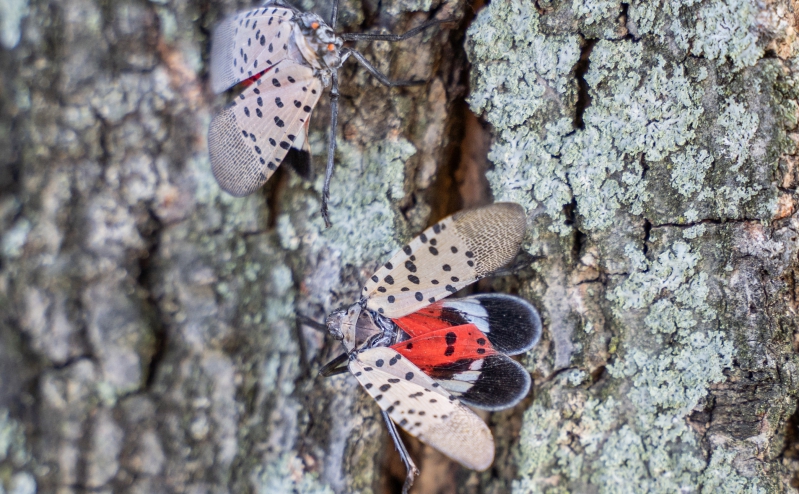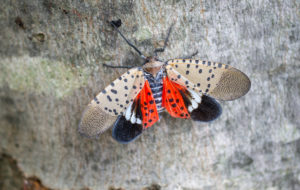
The battle against the spotted lanternfly is hobbled by regulatory challenges.
People living on the East Coast and West Coast of the United States have found an unlikely common enemy: the spotted lanternfly.
The U.S. Department of Agriculture’s Animal and Plant Health Inspection Service (APHIS) named the spotted lanternfly one of the country’s top 20 invasive pest threats. But with regulators only relying on state-by-state rules and the intervention of the public to stop the infestation, the lanternfly has rapidly spread into 11 states, posing a regulatory challenge.
The spotted lanternfly is native to China and classified as an invasive species in the United States due to the threat it poses to North American agriculture. Known as a “hitchhiker,” the lanternfly lays eggs on “almost any surface” and travels long distances on the cargo of unwitting travelers. The pest feeds on plants and trees, weakening crops and leaving behind a sticky residue that encourages mold growth. If left unmitigated, the lanternfly could cost nearly 3,000 agricultural jobs in Pennsylvania alone.
The pest is no stranger to the East Coast, moving into at least five other nearby states after it was first identified in the United States in Pennsylvania in 2014. The invasion sparked a quarantine order across 34 counties in Pennsylvania. The order regulated the movement of any object capable of carrying the lanternfly out of the quarantine area.
The quarantine order is far-reaching, requiring individuals to use a checklist and businesses to obtain a permit. Violations of the order can even carry criminal consequences: a maximum of 90 days in prison and a $300 fine per violation.
Similar quarantine orders have been implemented in adjacent states. Often these orders seek to encourage citizens to “stomp out” the pest.
The control effort across the United States, however, is disjointed, with an independent reporting system and regulatory scheme for each of the most impacted states.
Although the Pennsylvania Department of Agriculture has seen fewer spotted lanternflies in the Philadelphia region in 2021, in recent years lanternflies have been observed in areas increasingly remote from their original point of contact in the United States. Lanternflies have crept across the Northeast and as far as the Midwest in the form of larvae, egg masses, and even as an entry in an entomology fair.
Most alarming, though, have been dead specimens of lanternflies found in shipments as far west as Oregon and California. The emergence of the lanternfly prompted California to establish an exterior quarantine to prevent the pest’s entry. Oregon, however, elected not to offer even “control suggestions” when the state found the lanternfly.
With states responding in such different ways to the lanternfly’s migration, it is not surprising that the lanternfly is cropping up in more states each year. Environmental lawyer Jane Graham argues that a “lack of uniformity” in regulation across state lines coupled with insufficient federal coverage allows for the proliferation of invasive species.
Moreover, APHIS has not established any national quarantine protocols to combat the spotted lanternfly, although it has issued national orders for 12 of the other 19 most invasive pest threats. APHIS also generally regulates importers through federally approved, state-managed mitigation programs, but the agency has not put a program in place for the lanternfly.
Graham advocates the adoption of a comprehensive federal invasive species statute, arguing that the “patchwork” of current federal structures fails to strike the appropriate balance of prevention, punishment, and incentive. Graham also laments the potential challenges in instituting such a scheme, including funding concerns, constitutional limits, and questions about agency oversight. These questions and concerns only highlight the regulatory difficulties involved in trying to contain the rapid spread of the spotted lanternfly.
Even if a federal effort is made to curb the spotted lanternfly, one recent commentary appearing in a law journal posits that the “nearly impossible” task of controlling invasive species should be an international effort that has been made complicated by an interconnected world. The author of the commentary, attorney Christopher Regan, notes that free trade principles conflict with state attempts to keep out invasive species such as the spotted lanternfly. And although the spotted lanternfly is considered invasive in North America, it receives no special status in its native Asia, presenting another hurdle to keeping harmful insects from spreading internationally.
Regan argues that a species-specific international approach to mitigating invasive species would not be sufficiently comprehensive. That said, because the spotted lanternfly is already known to be harmful to the North American ecosystem, a species-specific approach to international shipping activity to the United States could prove to be effective at preventing more introductions of the pest.
Spotted lanternflies do not respect borders, whether they are federal, state, or international. Without a comprehensive federal and international approach to dealing with invasive species, the lanternfly is likely to be spotted in new areas around the country. In the meantime, it remains to be seen if state and federal regulators will employ the more aggressive options currently available to stop the spread of the pest.
Until the lanternfly stops spreading, the public will have to continue stomping.



